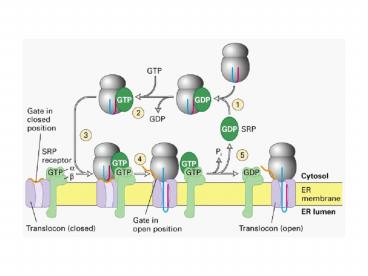Part 2: Intracellular trafficking - PowerPoint PPT Presentation
Title:
Part 2: Intracellular trafficking
Description:
Title: Part 2: Intracellular trafficking Author: KW Last modified by: KW Created Date: 2/20/2001 1:05:41 AM Document presentation format: On-screen Show – PowerPoint PPT presentation
Number of Views:156
Avg rating:3.0/5.0
Title: Part 2: Intracellular trafficking
1
(No Transcript)
2
(No Transcript)
3
Modified tRNAs allowed isolation (cross-linking
approach) and analysis (fluorescence quenching )
of translocation channel
4
In vitro reconstitution of ER translocation -
Sec61 complex conserved translocation channel
Sec61 subunits (a, b, g) Sec62/63
TRAM (translocating chain-assoc. membrane
protein) - phospholipids (proteoliposomes) and
luminal chaperones (BIP) - SRP/SRP receptor only
required for co-translational translocation not
for post-translational translocation (e.g
pre-pro-alpha factor). - energetics of
translocation protein conducting channel
(cotranslational) molecular
ratchetting (posttranslational)
5
From Beckmann et al. Cell (2001) Vol 107, 361-372
6
From Beckmann et al. Cell (2001) Vol 107, 361-372
7
Topology of membrane-spanning proteins
-gt Topogenic sequences determine orientation
8
Type I membrane proteins have a cleavable signal
sequence
Stop transfer sequence (hydrophobic) when
mutated -gt secretion
9
Type II membrane proteins have internal signal
sequence
Internal signal is not cleaved. Direction is
determined by residues outside of hydrobhobic
helix (-outside rule postive aa face cytoplasm)
10
From Beckmann et al. Cell (2001) Vol 107, 361-372
11
Translocation of proteins with multiple membrane
spanning domains
12
Formation of a glycosylphosphatidylinositol
(GPI)-anchor
13
ER function
- Proper folding of proteins (chaperones,
lectins, petidyl-prolyl-isomerases) -
Formation of disulfide bonds (PDI) GSH prevents
oxidation in cytosol GS-SG NADPH H ltgt 2
GSH NADP - Proteolytic cleavages - Addition
processing of carbohydrates - Assembly into
multimeric proteins - Ca2 storage - Lipid
synthesis - Detoxification (liver!)
14
(No Transcript)
15
Folding of Influenza hemagglutinin (HA)
16
Ser/Thr
17
(No Transcript)
18
(No Transcript)
19
(No Transcript)
20
(No Transcript)
21
(No Transcript)
22
(No Transcript)
23
(No Transcript)
24
Movies
25
(No Transcript)
26
(No Transcript)
27
(No Transcript)
28
(No Transcript)
29
(No Transcript)
30
(No Transcript)
31
(No Transcript)
32
(No Transcript)
33
(No Transcript)
34
(No Transcript)
35
Summary
ER translocation SRP-dependent and -independent
pathways translocation occurs through Sec61
complex topogenic sequences determine overall
orientation. ER function Compartmental
identity maturation versus fixed
compartments Identification of components
combination of genetics, biochemistry... Vesicula
r coats COPI retrograde Golgi-gtER
COPII anterograde ER-gtGolgi CCV
post-Golgi, various adaptors































